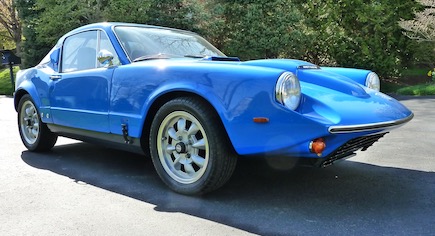Recharging
The lithium electric 356 does not use any gasoline or engine oil. It does require transmission fluid and grease for the suspension. But the tedium and expense of filling up at a gas station is eliminated.

AC charger replaces the gas tank under the hood
However, in order to recharge the lithium battery pack using household AC current, the car requires an on-board AC to DC charger that can regulate input voltage and shutoff automatically when the pack is fully charged.
To maximize pack life, the charger utilizes a specific volt and amp profile for 120AC/15amp residential service.
A full recharge can be completed overnight (typically 10-12 hours) and costs under $3.
The electric conversion fits 16 cells into the front compartment hold originally designed for a spare tire (there is no spare in the electric version). The rear engine bay contains 20 cells arranged in “saddle bags” of 10 each on either side of the electric motor.
The 36-cell pack weighs about 445 pounds, about five times the weight of a full gas tank. While the electric motor saves some weight compared to a fully dressed air-cooled engine, the electric 356 curb weight is still about 17% more than the 1957 original.
Fortunately, the battery pack placement achieves an equal weight distribution front-to-rear, and the cell position creates a low center of gravity. Aided by heavy duty coil-over shocks, the car still handles like the original with similar acceleration and top speed.

Charge anywhere with a common 3-prong outlet
The Cars
Porsche 356 Speedster

The iconic Porsche Speedster proved to be an excellent EV conversion candidate due to its low weight, relatively simple design, and ample front/rear compartments for mounting pristmatic lithium battery cells. Weight distribution was improved over the original rear engine configuration with better acceleration and overall performance.
Saab Sonett

The unusual fiberglass Sonett, originally powered by a Ford V4 engine, combines a low center of gravity and front wheel drive, optimal for our high performance EV conversion. Without the need to accomodate a long drive train, the space behind the two seats was used for additional batteries. The original four-speed transmission remains intact along with the braking system.